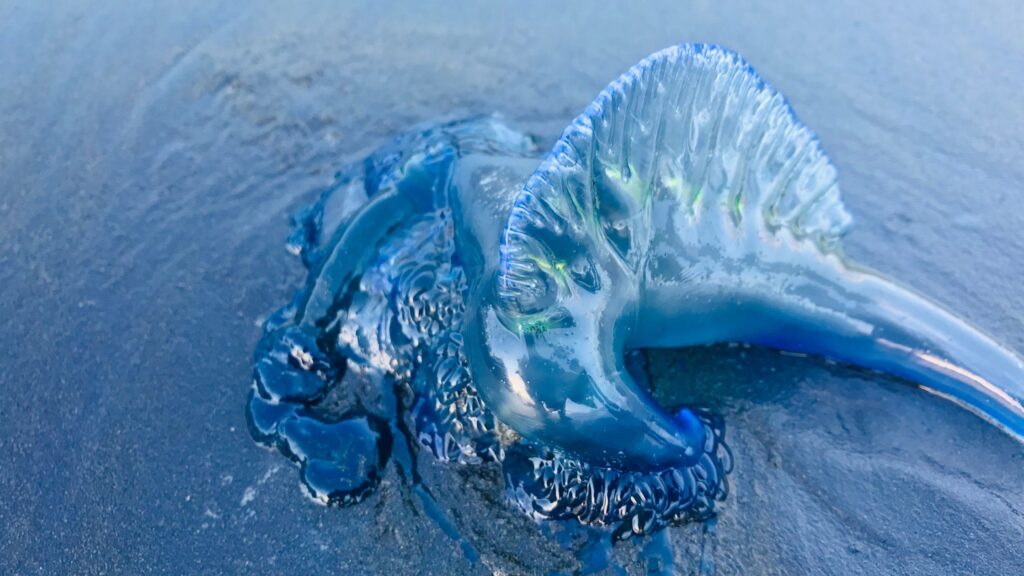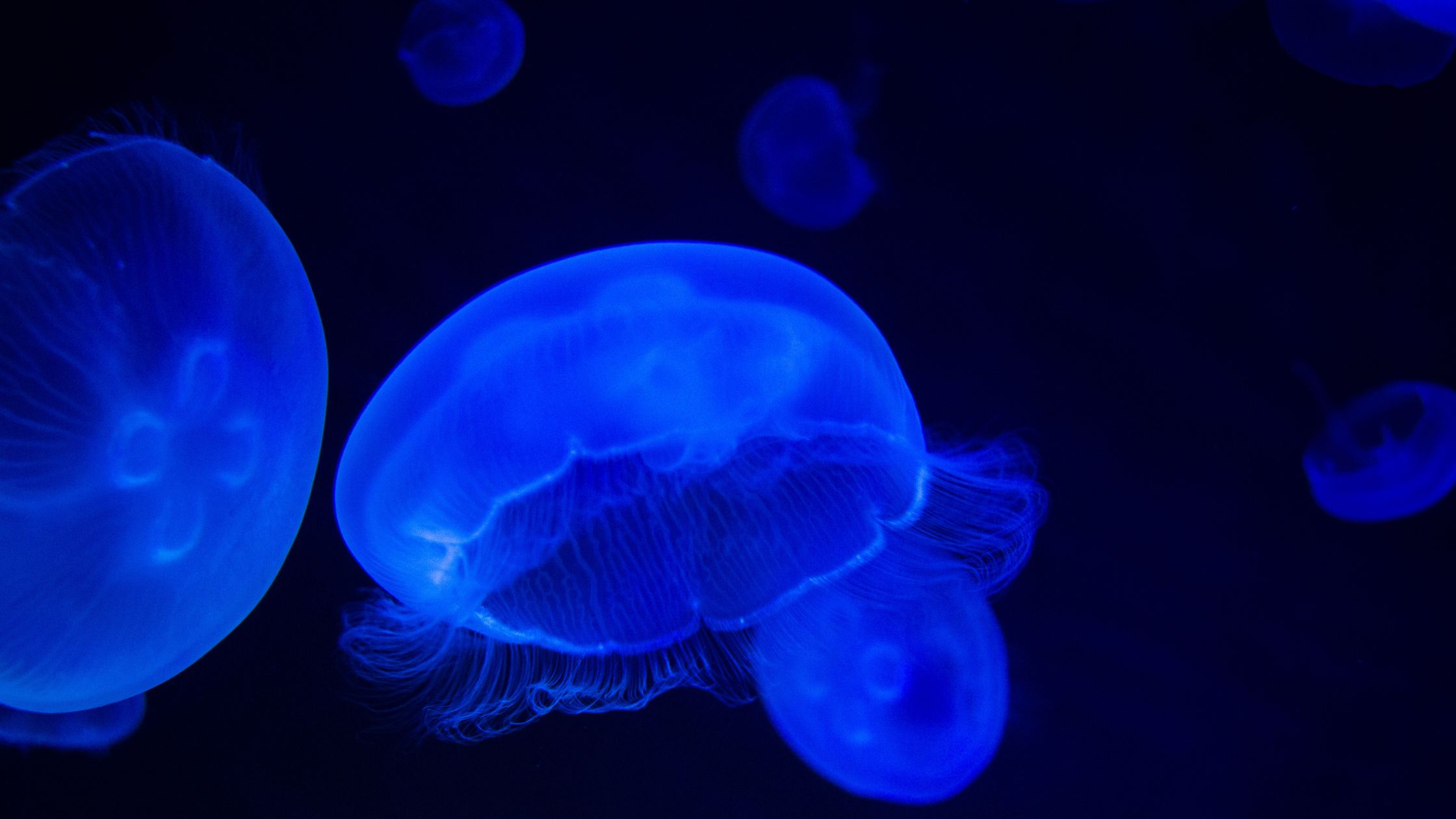- Get out of the Water
If you happen to get stung by a jellyfish while swimming it’s important to stay calm and composed. Avoid panicking and swim away from the area where the incident occurred. Leaving the water promptly will reduce the chances of getting stung. Do not go back into the water until you have treated the sting and assessed the situation. - Avoid Rubbing the Affected Area
Even though it might be tempting to scratch or rub the sting resist that urge. Rubbing can actually make the pain worse. Cause more venom to be released into your skin by those nematocysts (stinging cells). It’s crucial to be patient at this stage as minimizing movement will help prevent venom from spreading and alleviate discomfort. - Use Vinegar
Vinegar is an first aid remedy for jellyfish stings. Look for vinegar with around 5% acid content as it helps neutralize nematocysts and reduces venom release. Thoroughly pour vinegar over the area for 30 seconds. This treatment is particularly beneficial when dealing with species, like box jellyfish that possess venom. - Remove Visible Stingers and Tentacles
If you spot any tentacles or visible stingers on your skin carefully and gently use your fingers to pluck them out. However be cautious not to touch the tentacles as they can still sting when detached from the jellyfish. To safeguard your hands you may consider using a towel or a stick as a barrier while removing the tentacles. - Rinse, with Saltwater
Once you’ve removed any tentacles rinse the area of the sting with saltwater. It’s preferable to use saltwater of freshwater since the latter may cause the nematocysts to release venom thus intensifying the pain. The gentle flow of saltwater will help flush out any remaining venom and provide soothing relief at the site. - Apply Warm Water Treatment
One of the ways to alleviate pain and neutralize venom is by applying warm water to the affected area. Look for water with a temperature between 104 106 degrees Fahrenheit (40 41 degrees Celsius). Soak the sting for at 20 minutes. The warm water helps deactivate the venom offering relief from that burning sensation. If warm water is not immediately available you can use a compress. Immerse the affected body part, in lukewarm water.
If you find that most jellyfish stings can be effectively managed with the steps mentioned above it’s important to note that there are cases where professional medical attention may be necessary. If your symptoms worsen despite following the actions or if you experience reactions, like difficulty breathing, gastrointestinal problems or signs of an allergic reaction it’s crucial to seek immediate medical help.
It’s always best to prevent stings in the place. Stay informed about jellyfish populations in your area pay attention to warning signs at beaches and consider wearing clothing when swimming or snorkeling. By being cautious and prepared you can ensure an enjoyable experience, in Costa Rica’s waters while admiring its marine life.
How Express Medical Can Help with Jellyfish Stings

A Comprehensive Guide to Symptoms, Treatment, and Safety Measures 3
Although most jellyfish stings can be effectively managed with aid there may be situations where it becomes necessary to seek professional medical attention. In cases Express Medical Costa Rica serving the Manuel Antonio help. For assistance call +506-8836-2669 (Costa Rica) or +1(530)636-2669 (USA).
- Round the Clock Availability; Express Medical Costa Rica understands that emergencies can happen at any time during beach outings when encounters with jellyfish might occur. They provide 24/7 assistance ensuring that help is readily accessible whenever needed.
- Immediate On Site Response; If a jellyfish sting requires attention Express Medical Costa Rica can promptly meet you directly at the beach or marina to provide prompt care. Their skilled medical professionals are equipped to evaluate the severity of the sting and offer treatment.
- Expertise, in Handling Jellyfish Stings; The medical team at Express Medical Costa Rica is well versed in treating stings well as other common injuries that occur at the beach. They have experience in managing types of envenomation cases and will provide reassurance that you are, in capable hands.
- Advanced Treatment Options; In cases of jellyfish stings where symptoms worsen or allergic reactions occur Express Medical Costa Rica has the capability to administer advanced treatment options.
- They have the necessary resources and knowledge to quickly and effectively deal with any issues that may occur.
- Convenience for Travelers; For travelers exploring the Manuel Antonio region, Express Medical Costa Rica offers a convenient option for medical care. Their friendly staff can assist with language barriers. Provide medical services promptly and efficiently.
FAQ’s
What should you avoid when treating the sting of a jellyfish?
It is recommended to use vinegar to neutralize the venom. However be cautious. Avoid using substances, like ammonia, urine, rubbing alcohol, fresh water or ice as they can potentially trigger the release of venom. In case you don’t have vinegar at hand you can proceed by scraping off the stingers.
What should you avoid when treating the sting of a jellyfish?
If you decide to seek care for a severe jellyfish sting your healthcare provider may administer medication as part of the treatment. These medications could include pain relievers to alleviate discomfort and antivenin that helps counteract the effects of the venom.
Under what circumstances should I seek emergency help for a sting?
It is crucial to seek assistance if you experience increasing pain or any signs of difficulty breathing or chest pains. As soon as possible after being stung thoroughly rinse the affected area with household vinegar for 30 seconds. Vinegar is considered safe and effective for treating types of stings.
How can one determine if a jellyfish sting has become infected?
If redness and irritation persist beyond 2- 3 days after being stung by a jellyfish it could indicate an infection, in the wound.
Fascinating Facts about Jellyfish in Costa Rica
The marine ecosystem in Costa Rica is teeming with an array of captivating creatures and among them jellyfish hold a place. These gelatinous beings are not mesmerizing to observe. Also possess intriguing qualities that set them apart. Here are some intriguing tidbits about jellyfish in Costa Rica:
- Diverse Species
The waters of Costa Rica harbor a variety of jellyfish species. From the Moon Jellyfish (Aurelia aurita) to the Portuguese Man O’ War (Physalia physalis) these gelatinous organisms come in different shapes, sizes and hues contributing to the country’s biodiversity. - Venom
Jellyfish possess cells known as nematocysts, which reside in their trailing tentacles. These tiny harpoons inject venom into their prey or potential threats upon contact. The venom composition can differ among species. Certain jellyfish found in Costa Rica boast potent venom. - Sting Sensations
A encounter with a jellyfish can evoke sensations in humans ranging from discomfort to intense pain. The common reaction includes a burning or stinging feeling, at the site often accompanied by itching and a rash. It’s interesting how the burning sensation is usually the feeling people experience while they may not even notice the sting. - Non fatal Encounters
While jellyfish stings can be painful and uncomfortable most encounters, with jellyfish in Costa Rica do not result in harm or risk to life. The majority of stings lead to symptoms that can be managed with treatment procedures. However it’s important to be cautious and follow protocols to avoid complications. - Environmental Indicators
The population of jellyfish plays a role as an indicator of the marine ecosystems health. Their abundance reflects changes in water quality, temperature and prey availability. Monitoring populations provides information about the overall condition of Costa Ricas coastal environment. - Seasonal Trends
In Costa Rica, sightings and encounters with jellyfish often follow patterns. Some species may be more common, during months while others appear sporadically throughout the year. It’s important for beachgoers and marine enthusiasts to understand the variations, in presence so they can stay informed and take necessary precautions.
Conservation efforts in Costa Rica focus on protecting the balance of marine ecosystems and preserving the biodiversity that these captivating jellyfish species contribute to. Just like marine creatures jellyfish face threats such as habitat degradation, pollution and climate change.
Jellyfish play roles in marine ecosystems. They serve as both predators and prey being a food source for marine organisms like sea turtles and certain fish species. Additionally they help regulate plankton populations, which have an effect on the marine food web.
In recent years citizen science initiatives like “Jellyfish Watch” have emerged in Costa Rica and other parts of the world. These projects encourage locals and tourists to report sightings and encounters providing data for scientific research and conservation efforts.
The enchanting appearance of jellyfish in Costa Rica captivates both enthusiasts and scientists. As these gelatinous creatures continue to thrive in waters it becomes increasingly important to understand their role in the ecosystem, for conservation purposes and sustainable management practices.
Conclusion
While encountering a jellyfish sting can be an unpleasant experience, knowing how to respond can make a significant difference in alleviating the pain and discomfort. By following the appropriate steps outlined in this blog post, you can effectively treat jellyfish stings and enjoy a safer beach outing in the beautiful waters of Manuel Antonio. Remember to remain calm, seek medical attention if necessary, and be cautious of unproven remedies to ensure a pleasant beach experience.
For more information on jellyfish sting treatments and tips for safe beach experiences, visit our blog. If you require immediate medical assistance or advice, don’t hesitate to contact us through WhatsApp at your WhatsApp link. We’re here to help you enjoy a safe and enjoyable time at the beaches of Costa Rica!
When basking in the sun at the beautiful beaches of Manuel Antonio, one might encounter jellyfish lurking beneath the surface. Although often unnoticed until the sting, these creatures can be present in groups, especially near sunset or sunrise. Jellyfish stings can result in a burning or stinging sensation, along with other uncomfortable symptoms such as rashes and itching. While most encounters are only mildly painful, it’s essential to know how to respond effectively if stung. In this blog post, we’ll explore the treatment of jellyfish stings and learn the best practices to alleviate discomfort and promote a safe beach experience.
What you will learn:
In this blog post, we will explore the appropriate measures to take if you or someone you’re with encounters a jellyfish sting while enjoying the waters of Manuel Antonio. We’ll provide step-by-step guidance on how to handle jellyfish stings, from immediate responses upon contact to subsequent treatment.
Additionally, we’ll shed light on certain practices that are not routinely recommended but may or may not help, depending on the jellyfish species. By the end of this post, you’ll be equipped with the essential knowledge to mitigate the discomfort caused by jellyfish stings and ensure a safer and more enjoyable beach experience.
Types of Jellyfish in Waters
Costa Rican waters are home to a diverse range of jellyfish species, each with its own unique characteristics and venom strength. Some of the encountered jellyfish species in these waters include the Moon Jellyfish (Aurelia aurita) and the Portuguese Man O’ War (Physalia physalis). Understanding these jellyfish species is crucial, for identifying risks.
Nematocysts and Venomous Stings
Jellyfish employ nematocysts. Specialized stinging cells. As a defense mechanism. Upon contact these cells release venom into the victims body causing symptoms associated with stings. The composition of venom can vary among jellyfish species resulting in reactions.
Signs of Jellyfish Stings
When you get stung by a jellyfish you’ll usually feel a burning or stinging sensation where it touched you. This initial feeling might be more noticeable, than the sting itself which can sometimes go unnoticed. On you might develop a rash and itching around the area making the discomfort worse. Depending on the person and the type of jellyfish involved other symptoms may appear, including;
- Pain; When the jellyfish’s tentacles come into contact, with your skin you will feel intense pain in the area.
- Redness; The skin surrounding the site may turn red. Become inflamed.
- Itching; Some people may experience itching in the area that has been stung.
- Swelling; The sting site can swell up. This swelling might spread to areas.
- Raised welts; You may develop raised welts or hives around the spot where you were stung.
- Skin rash; A rash can appear on your skin causing itchiness and discomfort.
- Burning sensation; The sting can cause a burning or stinging feeling on your skin.
- Numbness; In cases you might feel numbness around the area.
- Tingling; You may experience tingling sensations, in the region.
- Muscle cramps; Severe stings have been known to lead to muscle cramps or spasms.
- Nausea and vomiting; In instances a jellyfish sting can result in feelings of nausea and vomiting.
- Headache; Some individuals may develop headaches after being stung by a jellyfish.
It’s essential to note that reactions to jellyfish stings can vary depending on the individual and the type of jellyfish involved. If you or someone else is stung by a jellyfish and experiences severe symptoms, seek immediate medical attention.
Recognizing Serious Reactions
While most jellyfish stings are not life threatening in some cases severe reactions can occur. It’s important to know what signs indicate a response such as;
- Difficulty breathing or having shortness of breath
- Irregular heartbeat or chest pain
- Feeling confused or disoriented
- Experiencing severe swelling at the sting site
- Developing hives or a widespread rash
If any of these symptoms appear, seeking immediate medical attention is crucial.
A Step by Step Guide for the Treatment of Jellyfish Stings
When dealing with stings it’s important to take appropriate measures to alleviate symptoms and aid, in recovery. Here are some recommended steps:
- Get out of the Water
If you happen to get stung by a jellyfish while swimming it’s important to stay calm and composed. Avoid panicking and swim away from the area where the incident occurred. Leaving the water promptly will reduce the chances of getting stung. Do not go back into the water until you have treated the sting and assessed the situation. - Avoid Rubbing the Affected Area
Even though it might be tempting to scratch or rub the sting resist that urge. Rubbing can actually make the pain worse. Cause more venom to be released into your skin by those nematocysts (stinging cells). It’s crucial to be patient at this stage as minimizing movement will help prevent venom from spreading and alleviate discomfort. - Use Vinegar
Vinegar is an first aid remedy for jellyfish stings. Look for vinegar with around 5% acid content as it helps neutralize nematocysts and reduces venom release. Thoroughly pour vinegar over the area for 30 seconds. This treatment is particularly beneficial when dealing with species, like box jellyfish that possess venom. - Remove Visible Stingers and Tentacles
If you spot any tentacles or visible stingers on your skin carefully and gently use your fingers to pluck them out. However be cautious not to touch the tentacles as they can still sting when detached from the jellyfish. To safeguard your hands you may consider using a towel or a stick as a barrier while removing the tentacles. - Rinse, with Saltwater
Once you’ve removed any tentacles rinse the area of the sting with saltwater. It’s preferable to use saltwater of freshwater since the latter may cause the nematocysts to release venom thus intensifying the pain. The gentle flow of saltwater will help flush out any remaining venom and provide soothing relief at the site. - Apply Warm Water Treatment
One of the ways to alleviate pain and neutralize venom is by applying warm water to the affected area. Look for water with a temperature between 104 106 degrees Fahrenheit (40 41 degrees Celsius). Soak the sting for at 20 minutes. The warm water helps deactivate the venom offering relief from that burning sensation. If warm water is not immediately available you can use a compress. Immerse the affected body part, in lukewarm water.
If you find that most jellyfish stings can be effectively managed with the steps mentioned above it’s important to note that there are cases where professional medical attention may be necessary. If your symptoms worsen despite following the actions or if you experience reactions, like difficulty breathing, gastrointestinal problems or signs of an allergic reaction it’s crucial to seek immediate medical help.
It’s always best to prevent stings in the place. Stay informed about jellyfish populations in your area pay attention to warning signs at beaches and consider wearing clothing when swimming or snorkeling. By being cautious and prepared you can ensure an enjoyable experience, in Costa Rica’s waters while admiring its marine life.
How Express Medical Can Help with Jellyfish Stings

A Comprehensive Guide to Symptoms, Treatment, and Safety Measures 4
Although most jellyfish stings can be effectively managed with aid there may be situations where it becomes necessary to seek professional medical attention. In cases Express Medical Costa Rica serving the Manuel Antonio help. For assistance call +506-8836-2669 (Costa Rica) or +1(530)636-2669 (USA).
- Round the Clock Availability; Express Medical Costa Rica understands that emergencies can happen at any time during beach outings when encounters with jellyfish might occur. They provide 24/7 assistance ensuring that help is readily accessible whenever needed.
- Immediate On Site Response; If a jellyfish sting requires attention Express Medical Costa Rica can promptly meet you directly at the beach or marina to provide prompt care. Their skilled medical professionals are equipped to evaluate the severity of the sting and offer treatment.
- Expertise, in Handling Jellyfish Stings; The medical team at Express Medical Costa Rica is well versed in treating stings well as other common injuries that occur at the beach. They have experience in managing types of envenomation cases and will provide reassurance that you are, in capable hands.
- Advanced Treatment Options; In cases of jellyfish stings where symptoms worsen or allergic reactions occur Express Medical Costa Rica has the capability to administer advanced treatment options.
- They have the necessary resources and knowledge to quickly and effectively deal with any issues that may occur.
- Convenience for Travelers; For travelers exploring the Manuel Antonio region, Express Medical Costa Rica offers a convenient option for medical care. Their friendly staff can assist with language barriers. Provide medical services promptly and efficiently.
FAQ’s
What should you avoid when treating the sting of a jellyfish?
It is recommended to use vinegar to neutralize the venom. However be cautious. Avoid using substances, like ammonia, urine, rubbing alcohol, fresh water or ice as they can potentially trigger the release of venom. In case you don’t have vinegar at hand you can proceed by scraping off the stingers.
What should you avoid when treating the sting of a jellyfish?
If you decide to seek care for a severe jellyfish sting your healthcare provider may administer medication as part of the treatment. These medications could include pain relievers to alleviate discomfort and antivenin that helps counteract the effects of the venom.
Under what circumstances should I seek emergency help for a sting?
It is crucial to seek assistance if you experience increasing pain or any signs of difficulty breathing or chest pains. As soon as possible after being stung thoroughly rinse the affected area with household vinegar for 30 seconds. Vinegar is considered safe and effective for treating types of stings.
How can one determine if a jellyfish sting has become infected?
If redness and irritation persist beyond 2- 3 days after being stung by a jellyfish it could indicate an infection, in the wound.
Fascinating Facts about Jellyfish in Costa Rica
The marine ecosystem in Costa Rica is teeming with an array of captivating creatures and among them jellyfish hold a place. These gelatinous beings are not mesmerizing to observe. Also possess intriguing qualities that set them apart. Here are some intriguing tidbits about jellyfish in Costa Rica:
- Diverse Species
The waters of Costa Rica harbor a variety of jellyfish species. From the Moon Jellyfish (Aurelia aurita) to the Portuguese Man O’ War (Physalia physalis) these gelatinous organisms come in different shapes, sizes and hues contributing to the country’s biodiversity. - Venom
Jellyfish possess cells known as nematocysts, which reside in their trailing tentacles. These tiny harpoons inject venom into their prey or potential threats upon contact. The venom composition can differ among species. Certain jellyfish found in Costa Rica boast potent venom. - Sting Sensations
A encounter with a jellyfish can evoke sensations in humans ranging from discomfort to intense pain. The common reaction includes a burning or stinging feeling, at the site often accompanied by itching and a rash. It’s interesting how the burning sensation is usually the feeling people experience while they may not even notice the sting. - Non fatal Encounters
While jellyfish stings can be painful and uncomfortable most encounters, with jellyfish in Costa Rica do not result in harm or risk to life. The majority of stings lead to symptoms that can be managed with treatment procedures. However it’s important to be cautious and follow protocols to avoid complications. - Environmental Indicators
The population of jellyfish plays a role as an indicator of the marine ecosystems health. Their abundance reflects changes in water quality, temperature and prey availability. Monitoring populations provides information about the overall condition of Costa Ricas coastal environment. - Seasonal Trends
In Costa Rica, sightings and encounters with jellyfish often follow patterns. Some species may be more common, during months while others appear sporadically throughout the year. It’s important for beachgoers and marine enthusiasts to understand the variations, in presence so they can stay informed and take necessary precautions.
Conservation efforts in Costa Rica focus on protecting the balance of marine ecosystems and preserving the biodiversity that these captivating jellyfish species contribute to. Just like marine creatures jellyfish face threats such as habitat degradation, pollution and climate change.
Jellyfish play roles in marine ecosystems. They serve as both predators and prey being a food source for marine organisms like sea turtles and certain fish species. Additionally they help regulate plankton populations, which have an effect on the marine food web.
In recent years citizen science initiatives like “Jellyfish Watch” have emerged in Costa Rica and other parts of the world. These projects encourage locals and tourists to report sightings and encounters providing data for scientific research and conservation efforts.
The enchanting appearance of jellyfish in Costa Rica captivates both enthusiasts and scientists. As these gelatinous creatures continue to thrive in waters it becomes increasingly important to understand their role in the ecosystem, for conservation purposes and sustainable management practices.
Conclusion
While encountering a jellyfish sting can be an unpleasant experience, knowing how to respond can make a significant difference in alleviating the pain and discomfort. By following the appropriate steps outlined in this blog post, you can effectively treat jellyfish stings and enjoy a safer beach outing in the beautiful waters of Manuel Antonio. Remember to remain calm, seek medical attention if necessary, and be cautious of unproven remedies to ensure a pleasant beach experience.
For more information on jellyfish sting treatments and tips for safe beach experiences, visit our blog. If you require immediate medical assistance or advice, don’t hesitate to contact us through WhatsApp at your WhatsApp link. We’re here to help you enjoy a safe and enjoyable time at the beaches of Costa Rica!




